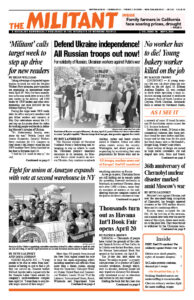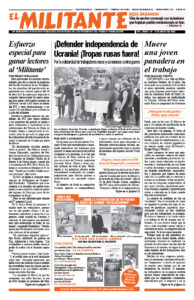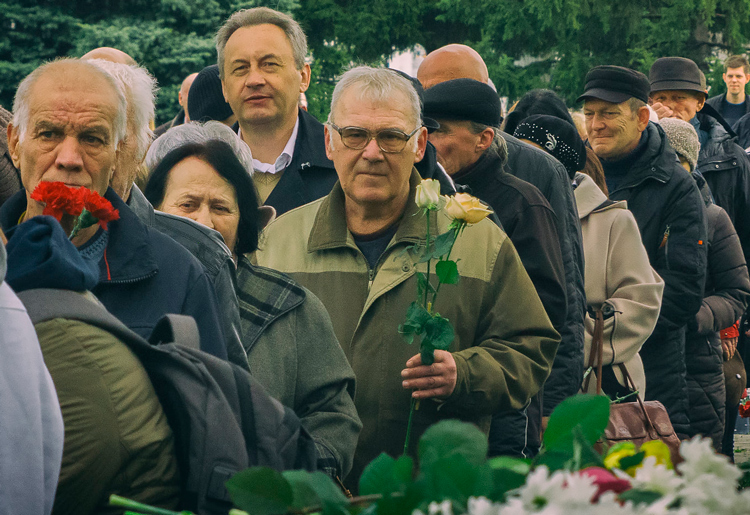Moscow’s war against Ukraine, and over the one-month-long occupation of Chernobyl, has brought renewed attention to the 1986 nuclear disaster there and its continuing effects.
Russian troops occupied the site Feb. 24, the first day of the invasion, and a month later took over the nearby town of Slavutych, where most workers at the plant live. They were forced to withdraw by the Ukrainian resistance March 31, less than a month before the 36th anniversary of the worst nuclear “accident” ever.
Members of the nuclear workers ATOM union were part of protests in Slavutych during the occupation, demanding the invading troops get out.
Workers at the plant told Reuters that many of the young soldiers they spoke to “had no idea what kind of facility they were at” and “did not have a clue” about the April 26, 1986, explosion that destroyed a nuclear reactor there. The resulting fire raged out of control for 10 days, spewing nuclear radiation into the atmosphere and leaving some 1,000 square miles in what is called the Chernobyl “exclusion zone,” virtually off limits to this day.
Ignoring the warnings of the Ukrainian nuclear workers, who took the moral high ground toward the occupation forces, the Russian generals ordered their troops to drive vehicles through the “Red Forest,” the highest contaminated area, where the explosion and fire turned the leaves red. The soldiers kicked up dust all over, and were ordered to dig trenches in the still radioactive ground near the site. Soldiers lived in the bunkers for more than a month.
The Russian military brass under the capitalist regime of Vladimir Putin has no more regard for the lives of the workers and farmers in uniform they send to fight in their war of conquest than they do for the lives of the people of Ukraine.
That is no surprise. It was the same disdain for working people shown by the Stalinist regime in power in Moscow in 1986 that led to the disaster in the first place, when the region was still part of the Soviet Union.
April 26, 1986
The disaster began with the dangerously flawed design of the four nuclear reactors in operation at Chernobyl. These reactors were inherently unstable because of the way they used graphite instead of water to cool them. On top of this, the Stalinist regime refused to build any fortified containment structure, unlike most nuclear power plants in the world.
Operators lost control during a maintenance test of a unit. Over the next 10 days the fire released roughly 400 times more radiation than the atom bombs U.S. imperialism dropped on Hiroshima and Nagaski in Japan in 1945. Among the most dangerous of the over 100 radioactive elements released were iodine, with a half-life of eight days and strontium and caesium with half-lives of some 30 years.
Did the Stalinist authorities move rapidly to evacuate all those in immediate danger, like the 49,000 inhabitants of Pripyat just a couple of miles away, where the nuclear workers and their families lived? Did they sound the alarm throughout the region? Did they make sure that at least young children — who are most susceptible to the ill effects of radioactive iodine — would not drink contaminated milk?
They did none of those things, trying to cover up the disaster. For 36 hours they told Pripyat residents there was nothing to worry about. People in the surrounding area weren’t notified of anything unusual.
When they finally did evacuate people in the region, they did it bureaucratically, often giving people no time to gather their belongings. Over weeks they ordered some 600,000 troops and volunteers known as “liquidators” — often without protective gear — to join plant workers to put the fire out, help in the evacuation and cover the leaking reactor.
Two workers died in the explosion and 28 others, including the entire Chernobyl fire department, who were directly involved in the clean up died of acute radiation poisoning within weeks. How many people have died over the years since from cancers caused by radiation exposure is hotly disputed and likely will never be known.
The Ukrainian government has cut off payments to thousands of surviving liquidators, sparking protests in recent years, and still pays benefits to more than 36,000 of their widows. The International Atomic Energy Agency estimates that eventually some 9,000 people may die from cancers caused by Chernobyl, while the Union of Concerned Scientists says it expects 26,000 fatalities. The agency admits that at least 1,800 children got thyroid cancer, which fortunately is rarely fatal if treated.
In a demonstration of internationalist solidarity, the revolutionary government of Cuba provided free medical care in a special treatment center in Tarará from 1990 to 2011 for more than 25,000 people, overwhelmingly children affected by the nuclear meltdown. Cuban families volunteered to take the Chernobyl victims into their own homes to ensure they felt welcomed. The program was suspended when then Ukrainian President Viktor Yanukovych, backed by Moscow, stopped providing funds for transportation.
Militant editor John Studer and Militant correspondent Frank Forrestal visited with some of the children who were treated in Cuba, along with Liliya Piltyay, who had helped organize getting the youth to Cuba, while they were in Ukraine in 2014. They also visited Chernobyl and Slavutych at the invitation of the Nuclear Power Workers ATOM union. Unionists there told them how thousands of coal miners were part of digging a tunnel under the wreckage to install a coil to cool the concrete floor of the reactor.
The selflessness of Ukrainian workers fighting to contain the damage — like the solidarity given by Cuba — stands in sharp contrast to the cover-up and brutality of the Stalinist regime in 1986 and of the invading capitalist regime in Moscow today.


